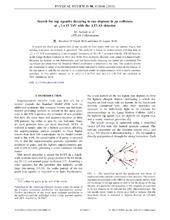Search for top squarks decaying to tau sleptons in pp collisions at √s=13 TeV with the ATLAS detector
Aaboud, Morad; Aad, Georges; Abbott, Brad; Abdinov, Ovsat Bahram oglu; Abeloos, Baptiste; Abidi, Syed Haider; AbouZeid, Hass; Abraham, Nadine L.; Abramowicz, Halina; Abreu, Henso; Buanes, Trygve; Dale, Ørjan; Eigen, Gerald; Fomin, Nikolai; Lipniacka, Anna; Martin dit Latour, Bertrand; Mæland, Steffen; Stugu, Bjarne; Yang, Zongchang; Zalieckas, Justas; Bugge, Magnar Kopangen; Cameron, David Gordon; Catmore, James Richard; Feigl, Simon; Franconi, Laura; Garonne, Vincent; Gramstad, Eirik; Hellesund, Simen; Morisbak, Vanja; Oppen, Henrik; Ould-Saada, Farid; Read, Alexander Lincoln; Røhne, Ole Myren; Sandaker, Heidi; Serfon, Cédric; Stapnes, Steinar; Vadla, Knut Oddvar Høie; Abulaiti, Yiming; Acharya, Bobby S.; Adachi, Shunsuke; Adamczyk, Leszek; Adelman, Jareed; Adersberger, Michael; Adye, Tim; Afik, Yoav; Agheorghiesei, Catalin; Aguilar Saavedra, Juan Antonio; Ahmadov, Faig; Aielli, Giulio; Akatsuka, Shunichi; ATLAS, Collaboration
Peer reviewed, Journal article
Published version

Åpne
Permanent lenke
https://hdl.handle.net/1956/20600Utgivelsesdato
2018-08Metadata
Vis full innførselSamlinger
Originalversjon
https://doi.org/10.1103/physrevd.98.032008Sammendrag
A search for direct pair production of top squarks in final states with two tau leptons, b-jets, and missing transverse momentum is presented. The analysis is based on proton-proton collision data at √s=13  TeV corresponding to an integrated luminosity of 36.1  fb−1 recorded with the ATLAS detector at the Large Hadron Collider in 2015 and 2016. Two exclusive channels with either two hadronically decaying tau leptons or one hadronically and one leptonically decaying tau lepton are considered. No significant deviation from the Standard Model predictions is observed in the data. The analysis results are interpreted in terms of model-independent limits and used to derive exclusion limits on the masses of the top squark ˜t1 and the tau slepton ˜τ1 in a simplified model of supersymmetry with a nearly massless gravitino. In this model, masses up to m(˜t1)=1.16  TeV and m(˜τ1)=1.00  TeV are excluded at 95% confidence level.
